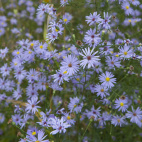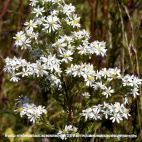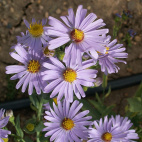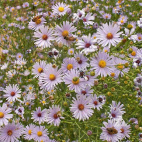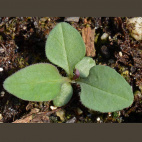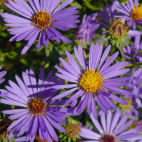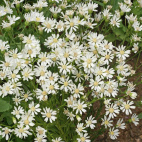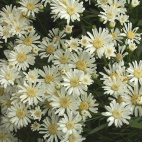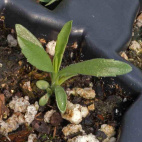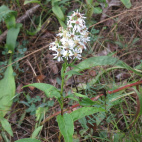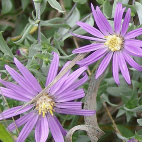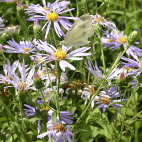New England Aster Seeds
- HOW TO GROW
- FAST FACTS
- REVIEWS
HOW TO GROW
Sowing: Direct sow New England Aster seeds in late fall, planting it just under the surface and watering it once. If direct sown in the spring, the seed must be stratified first by mixing it with moist sand and stored in the refrigerator for 60 days. To start the stratified seed indoors, sow purple flower seeds in a flat; keep the soil evenly moist and at a temperature of 65-70 degrees F until germination, which should take place within 14-20 days. Transplant the seedlings after the last frost of spring.
Growing: This plant prefers full sun and rich, well drained soil, but also tolerates sandy soil or clay in partial shade. New England Aster seeds grow best with regular watering, especially in dry weather. Keep in mind that too much moisture may cause root rot. Keep weeds under control, since this plant does not like competition. For bushy, compact growth, prune the plants early in the season before they bud. Mature plants may need staking or support. These asters spread by rhizomes and by reseeding, forming a colony over time if volunteer plants are not removed. Mature plants will benefit from division after two or three years of growth. Cut the stalks down to the ground at the end of the growing season for easier growth in the spring. The flowers attract numerous bees and butterflies, providing a valuable source of nectar in late fall.
Harvesting: Asters make lovely cut flowers. Cut the stems long, choosing flowers that have just opened.
Seed Saving: After flowering, the plant will produce seed heads containing small clusters of seed with white fluff. Since sparrows and goldfinches love to eat the seed, harvest it promptly to avoid loss. Cut the mature seed heads, or shake them into a container to remove the seed material. Clean New England Aster seeds as well as possible, then store it in a cool, dry place.
FAST FACTS
Common Names: Hardy Aster, Michaelmas Daisy
Latin Name: Aster novae-angliae
Species Origin: US Native Wildflower
Type: Native Wildflowers
Life Cycle: Perennial
USDA Zones: 2, 3, 4, 5, 6, 7, 8
US Regions: Northern, Northeast, Southeast
Seeds per Ounce: 71,000
Stratification: Cold/Wet for 8 Weeks
Germination Ease: Stratify 8 Weeks
Sunlight: Full Sun, Part Sun
Height: 48 Inches
Color: Pink, Purple
Bloom Season: Blooms Early Fall, Blooms Late Fall
Uses: Attracts Pollinators, Attracts Honeybees, Attracts Butterflies, Cut Flowers
Bee keeper
Excellent service, speed of delivery, and price? I will probably order more items.
Service
Had most excellent service. The seeds are in a foil pack to stay fresh longer.
Asters
The Astor seeds were planted as you directed. I'm believing that next spring I will be pleasantly surprised. Blessings
Awesome product!
Will plant aster seeds in fall. Looking forward to them germinating next year. What I like most about Everwilde's products is the foil packaging that's guaranteed to keep seeds fresh as well as the in-depth planting and growing information that's right on the seed packets. Most seed packets just provide generic information but Everwilde provides information specific to the plant/ flowers. Also you get a lot of seeds in one packet. I used to purchase seeds from this company before they switched packaging glad I came back. Will continue to purchase Everwilde seeds!!! Thank you for a quality product.
Asters
I think it will be a healthy addition to the garden. Because the seeds were healthy.
Asters
You run a excellent company. Your wide variety of native plants gives so many options for color, size and seasonal blooming. You are doing a good thing for bees, birds and diversity for all of us.
New England Aster Seeds
I can always count on Everwilde farms to ship seeds that transform into vigorous thriving plants. I use their seeds to plant my butterfly garden and they are always dependable! Everwilde Farms deliver their seeds in a mylar resealable pack that protects their seeds for seasons to come!
The girls and flowers
I got this for the wife I don't know how well it will grow since our winter feels like the middle of early summer at the moment
Late Season Show Stopper
This plant is a must-have for any garden, as it provides color, and pollen for the bees when not much else is available. It also comes back well year after year even in the harsh climate here in northern WI, and spreads well by means of its floating seeds.
DESCRIPTION
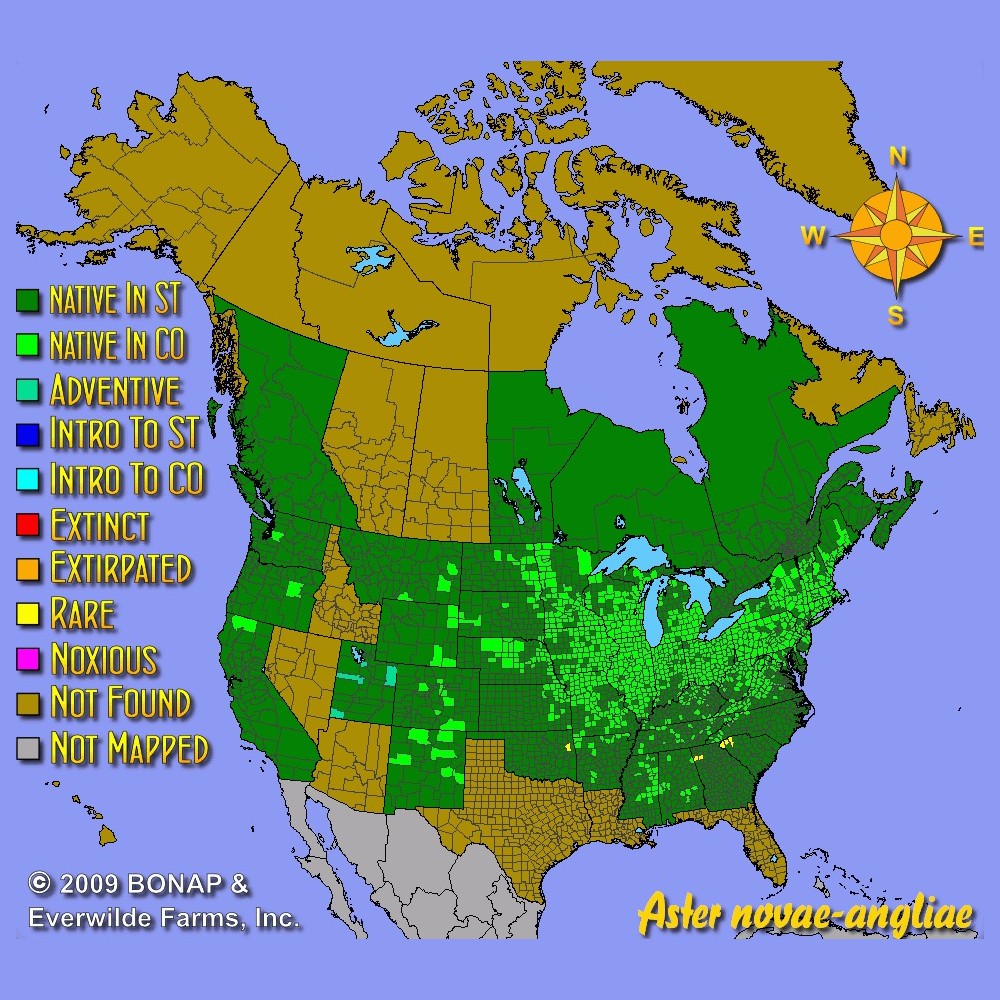
HOW TO GROW
Sowing: Direct sow New England Aster seeds in late fall, planting it just under the surface and watering it once. If direct sown in the spring, the seed must be stratified first by mixing it with moist sand and stored in the refrigerator for 60 days. To start the stratified seed indoors, sow purple flower seeds in a flat; keep the soil evenly moist and at a temperature of 65-70 degrees F until germination, which should take place within 14-20 days. Transplant the seedlings after the last frost of spring.
Growing: This plant prefers full sun and rich, well drained soil, but also tolerates sandy soil or clay in partial shade. New England Aster seeds grow best with regular watering, especially in dry weather. Keep in mind that too much moisture may cause root rot. Keep weeds under control, since this plant does not like competition. For bushy, compact growth, prune the plants early in the season before they bud. Mature plants may need staking or support. These asters spread by rhizomes and by reseeding, forming a colony over time if volunteer plants are not removed. Mature plants will benefit from division after two or three years of growth. Cut the stalks down to the ground at the end of the growing season for easier growth in the spring. The flowers attract numerous bees and butterflies, providing a valuable source of nectar in late fall.
Harvesting: Asters make lovely cut flowers. Cut the stems long, choosing flowers that have just opened.
Seed Saving: After flowering, the plant will produce seed heads containing small clusters of seed with white fluff. Since sparrows and goldfinches love to eat the seed, harvest it promptly to avoid loss. Cut the mature seed heads, or shake them into a container to remove the seed material. Clean New England Aster seeds as well as possible, then store it in a cool, dry place.
FAST FACTS
Common Names: Hardy Aster, Michaelmas Daisy
Latin Name: Aster novae-angliae
Species Origin: US Native Wildflower
Type: Native Wildflowers
Life Cycle: Perennial
USDA Zones: 2, 3, 4, 5, 6, 7, 8
US Regions: Northern, Northeast, Southeast
Seeds per Ounce: 71,000
Stratification: Cold/Wet for 8 Weeks
Germination Ease: Stratify 8 Weeks
Sunlight: Full Sun, Part Sun
Height: 48 Inches
Color: Pink, Purple
Bloom Season: Blooms Early Fall, Blooms Late Fall
Uses: Attracts Pollinators, Attracts Honeybees, Attracts Butterflies, Cut Flowers
Reviews
Review
Bee keeper
Excellent service, speed of delivery, and price? I will probably order more items.
Review
Service
Had most excellent service. The seeds are in a foil pack to stay fresh longer.
Review
Asters
The Astor seeds were planted as you directed. I'm believing that next spring I will be pleasantly surprised. Blessings
Review
Awesome product!
Will plant aster seeds in fall. Looking forward to them germinating next year. What I like most about Everwilde's products is the foil packaging that's guaranteed to keep seeds fresh as well as the in-depth planting and growing information that's right on the seed packets. Most seed packets just provide generic information but Everwilde provides information specific to the plant/ flowers. Also you get a lot of seeds in one packet. I used to purchase seeds from this company before they switched packaging glad I came back. Will continue to purchase Everwilde seeds!!! Thank you for a quality product.
Review
Asters
I think it will be a healthy addition to the garden. Because the seeds were healthy.
Review
Asters
You run a excellent company. Your wide variety of native plants gives so many options for color, size and seasonal blooming. You are doing a good thing for bees, birds and diversity for all of us.
Review
New England Aster Seeds
I can always count on Everwilde farms to ship seeds that transform into vigorous thriving plants. I use their seeds to plant my butterfly garden and they are always dependable! Everwilde Farms deliver their seeds in a mylar resealable pack that protects their seeds for seasons to come!
Review
The girls and flowers
I got this for the wife I don't know how well it will grow since our winter feels like the middle of early summer at the moment
Review
Late Season Show Stopper
This plant is a must-have for any garden, as it provides color, and pollen for the bees when not much else is available. It also comes back well year after year even in the harsh climate here in northern WI, and spreads well by means of its floating seeds.
Also Consider These:
-
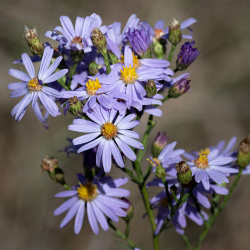 On Sale!
Sky Blue Aster Seeds
Aster azureus
These dainty, azure blue flowers will blanket a fall meadow in stunning beauty. A great source of pollen and nectar in the late fall. Also perfect for a vase or dried flower arrangement.Quick View$3.75 Pkt - $32.00 / Oz
On Sale!
Sky Blue Aster Seeds
Aster azureus
These dainty, azure blue flowers will blanket a fall meadow in stunning beauty. A great source of pollen and nectar in the late fall. Also perfect for a vase or dried flower arrangement.Quick View$3.75 Pkt - $32.00 / Oz -
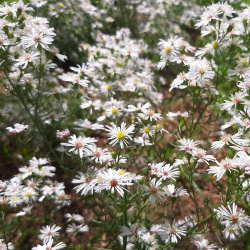 Heath Aster Seeds
Aster ericoides
Named for their resemblance to the white heath of the moors of England, these Asters thrive in dry, rocky prairies or pastures. Since it spreads easily, it will eventually form extended colonies of attractive white bushes.Quick View$3.75 Pkt - $100.00 / Oz
Heath Aster Seeds
Aster ericoides
Named for their resemblance to the white heath of the moors of England, these Asters thrive in dry, rocky prairies or pastures. Since it spreads easily, it will eventually form extended colonies of attractive white bushes.Quick View$3.75 Pkt - $100.00 / Oz -
 On Sale!
Smooth Blue Aster Seeds
Aster laevis
These bright blue flowers will add color to the autumn landscape. Unlike many asters, this variety produces perfectly smooth foliage and stems. This Aster is widely used in prairie restoration mixes.Quick View$3.75 Pkt - $15.95 / Oz
On Sale!
Smooth Blue Aster Seeds
Aster laevis
These bright blue flowers will add color to the autumn landscape. Unlike many asters, this variety produces perfectly smooth foliage and stems. This Aster is widely used in prairie restoration mixes.Quick View$3.75 Pkt - $15.95 / Oz -
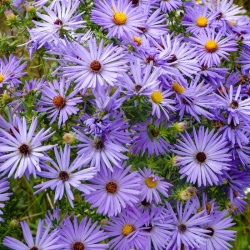 On Sale!
Aromatic Aster Seeds
Aster oblongifolius
Distinguished by its attractive balsam-scented foliage, this large Aster blooms very late in the fall. Though rather uncommon in the wild, this lavender variety usually grows in rough, dry ground or prairie soil.Quick View$3.75 Pkt - $48.00 / Oz
On Sale!
Aromatic Aster Seeds
Aster oblongifolius
Distinguished by its attractive balsam-scented foliage, this large Aster blooms very late in the fall. Though rather uncommon in the wild, this lavender variety usually grows in rough, dry ground or prairie soil.Quick View$3.75 Pkt - $48.00 / Oz -
 On Sale!
White Upland Aster Seeds
Aster ptarmicoides
Though not a true Aster, this plant is characterized by its profusion of white flowers. This variety does well in even the poorest, driest soil, and will provide some late-season color and nectar for winged garden visitors.Quick View$3.48 Pkt - $18.77 / Oz
On Sale!
White Upland Aster Seeds
Aster ptarmicoides
Though not a true Aster, this plant is characterized by its profusion of white flowers. This variety does well in even the poorest, driest soil, and will provide some late-season color and nectar for winged garden visitors.Quick View$3.48 Pkt - $18.77 / Oz -
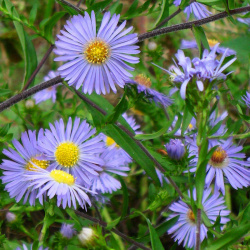 Swamp Aster Seeds
Aster puniceus
Found from northern Canada to southern Texas, this wildflower has one of the largest growing areas of any aster. The perennial usually grows in wetland or marshes, but will grow in average garden soil as well.Quick View$3.75 Pkt - $50.00 / Oz
Swamp Aster Seeds
Aster puniceus
Found from northern Canada to southern Texas, this wildflower has one of the largest growing areas of any aster. The perennial usually grows in wetland or marshes, but will grow in average garden soil as well.Quick View$3.75 Pkt - $50.00 / Oz -
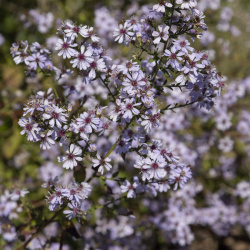 Arrow Leaved Aster Seeds
Aster sagittifolius
Delightful clusters of pale blue and lavender flowers add beauty to any planting in the fall season. Though no longer common in the wild, this Aster occasionally grows in open woodland areas or prairies.Quick View$3.75 Pkt - $54.00 / Oz
Arrow Leaved Aster Seeds
Aster sagittifolius
Delightful clusters of pale blue and lavender flowers add beauty to any planting in the fall season. Though no longer common in the wild, this Aster occasionally grows in open woodland areas or prairies.Quick View$3.75 Pkt - $54.00 / Oz -
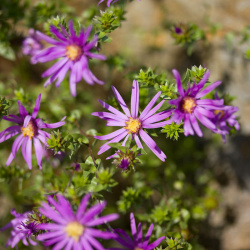 On Sale!
Silky Aster Seeds
Aster sericeus
Large flowers and attractive silvery foliage make this aster a popular choice for rock gardens and prairie plantings. The hardy, low-growing variety also distinguishes itself with unusual leaves, which feature fine white hairs.Quick View$3.96 Pkt - $64.00 / Oz
On Sale!
Silky Aster Seeds
Aster sericeus
Large flowers and attractive silvery foliage make this aster a popular choice for rock gardens and prairie plantings. The hardy, low-growing variety also distinguishes itself with unusual leaves, which feature fine white hairs.Quick View$3.96 Pkt - $64.00 / Oz -
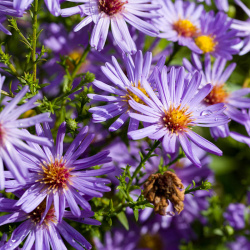 Out Of Stock
Showy Aster Seeds
Aster spectabilis
This New England native has become endangered in some states, though it can be found occasionally in coastal, sandy areas or open woods. Adaptability to almost any soil makes Aster Spectabilis an excellent choice for gardens or prairie plantings.Quick View$3.48 Pkt - $32.00 / Oz
Out Of Stock
Showy Aster Seeds
Aster spectabilis
This New England native has become endangered in some states, though it can be found occasionally in coastal, sandy areas or open woods. Adaptability to almost any soil makes Aster Spectabilis an excellent choice for gardens or prairie plantings.Quick View$3.48 Pkt - $32.00 / Oz








